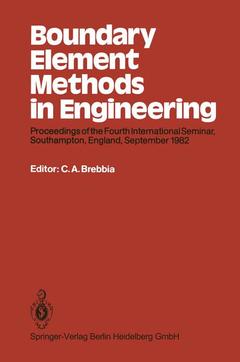Boundary Element Methods in Engineering, Softcover reprint of the original 1st ed. 1982 Proceedings of the Fourth International Seminar, Southampton, England, September 1982 Boundary Elements Series, Vol. 4
Langue : Anglais
Coordonnateur : Brebbia C. A.

One of the most interesting developments in engineering analysis during the last few years has been the rapid growth of boundary element methods. The first and second international conferences on this topic held in 1978 and 1980 attracted approximately 30 papers each, most of them from a few well known groups around the world. The third meeting in 1981, produced instead approximately 40 papers, many of them from young investigators working in newly created research groups. They have been attracted to boundary elements by the many advantages of the technique and were able to assimilate rapidly, the new ideas unencumbered by previous con ceptions. That third conference held in 1981 constituted in many ways a turning point for boundary elements and it indicated for the first time a general awareness of the industry to the research being carried out in the new technique. Engineering firms started to appreciate the advantages of the method mainly from the computa tional aided engineering point of view. The advantages of simple data input and output was rapidly understood by those professional engineers who were forced up to them to use cumbersome finite element codes. Boundary element practitioners in close contacts with the industry started to perceive that the method was gather ing a critical momentum of its own. This is now more evident by the diversity and quality of the papers in this volume, which are the edited Proceedings of the 4th International Conference, held at the University of Southampton in September 1982.
Theoretical and Experimental Asymptotic Convergence of the Boundary Integral Method for a Plane Mixed Boundary Value Problem.- Collocation Versus Galerkin Procedures for Boundary Integral Methods.- Solution of Free Boundary Problems using C-Complete Systems.- On the Use of Fundamental Solutions in Trefftz Method for Potential and Elasticity Problems.- Boundary Element and Dynamic Programming Method in Optimization of Transient Partial Differential Systems.- Some Improvements in 2D Boundary Elements using Integration by Parts.- The Robin Problem in a Multiply-Connected Domain.- Boundary Elements in Axisymmetric Potential Problems.- A Regular Boundary Method using Non-Conforming Elements for Potential Problems in Three Dimensions.- A Boundary Integral Equation Approach to the one Dimensional Ablation Problem.- Boundary Element Method in Singular and Nonlinear Heat Transfer.- Unsteady Heat Conduction using the Boundary Element Method.- Solution of Wave Propagation Problems by Boundary Elements.- Solution of the Wave Equation with Stiffness Boundary Conditions.- Computation of Wave Forces on Three Dimensional Offshore Structures.- Modified Integral Equation Solution of Steady Viscous Flow in a Bifurcating Channel.- An Implementation of Stress Discontinuity in the Boundary Element Method.- Application of Indirect Boundary Integral Method to Three-Dimensional Problems in the Linear, Couple-Stress Theory.- Applications of the Boundary Element Method to Two and Three Dimensional Stress Analysis and Plate Bending Problems in Elasticity.- On the Indeterminancy of Bie Solutions for the Exterior Problems of Time-Harmonic Elastodynamics and Incompressible Elastostatics.- Applications of the Boundary Integral Equation Method to Eigenvalue Problems of Elastodynamics.- A New Approach to Free Vibration Analysis using Boundary Elements.- Viscoplastic Analysis.- Numerical Anaylsis of Viscoplasticity using the Boundary Element Method.- Consolidation Analysis by Boundary Element Method.- Consolidation Problems.- The Application of Boundary Elements in Offshore Engineering.- The Second Generation Boundary Element Contact Program.- Boundary Element Method for Two-Dimensional Fracture Mechanics Problems.- The Edge Function Method for Three-Dimensional Stress Analysis, Including Embedded Elliptical Cracks and Surface Flaws.- A Boundary Element Method for Curved Crack Problems in Two Dimensions.- Application of the Direct Boundary Element Method to Reissner’s Plate Model.- Application of Complex Variable Theory to Boundary Element Method.- Boundary Element Nonlinear Bending Analyses of Clamped Sandwich Plates and Shells.- Integral Equation Approach to Small and Large Displacements of Thin Elastic Plates.- On the Computation of the Stress Intensity Factors in Elastic Plate Flexure Via Boundary Integral Equations.- Beasy A Boundary Element Analysis System.- The Boundary Element Method in an Industrial Environment.- Plane Intersections of a Three Dimensional Boundary Elements Mesh and Stress, Displacement Contour Plotting.- A New Boundary Condition Solved with B.I.E.M..- A Critical Study of Different Boundary Element Stiffness Matrices.- Analytical Combination of Boundary Element Method and Thin-Walled Segment Method and Its Application to Box Girder Bridges.
Date de parution : 07-2013
Ouvrage de 649 p.
15.5x23.5 cm
Disponible chez l'éditeur (délai d'approvisionnement : 15 jours).
Prix indicatif 52,74 €
Ajouter au panierMots-clés :
© 2024 LAVOISIER S.A.S.



